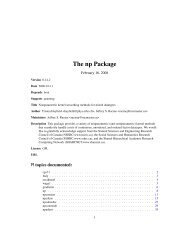An R Package for Univariate and Bivariate Peaks Over Threshold ...
An R Package for Univariate and Bivariate Peaks Over Threshold ...
An R Package for Univariate and Bivariate Peaks Over Threshold ...
- No tags were found...
You also want an ePaper? Increase the reach of your titles
YUMPU automatically turns print PDFs into web optimized ePapers that Google loves.
3.2.3 L-Moments plot: lmomplotL-moments are summary statistics <strong>for</strong> probability distributions <strong>and</strong> data samples. They are analogous toordinary moments – they provide measures of location, dispersion, skewness, kurtosis, <strong>and</strong> other aspectsof the shape of probability distributions or data samples – but are computed from linear combinations ofthe ordered data values (hence the prefix L).For the GPD, the following relation holds:where τ 4 is the L-Kurtosis <strong>and</strong> τ 3 is the L-Skewness.The L-Moment plot represents points defined by:τ 4 = τ 31 + 5τ 35 + τ 3(3.7){(ˆτ 3,u , ˆτ 4,u ) : u ≤ x max } (3.8)where ˆτ 3,u <strong>and</strong> ˆτ 4,u are estimations of the L-Kurtosis <strong>and</strong> L-Skewness based on excesses over threshold u<strong>and</strong> x max is the maximum of the observations x. The theoretical curve defined by equation (3.7) is tracedas a guideline.Here is a trivial example.> x lmomplot(x, u.range = c(0.9, quantile(x, probs = 0.9)), identify = FALSE)Figure 3.2.3 displays the L-Moment plot. By passing option identiy = TRUE user can click on the graphicto identify the threshold related to the point selected.We found that this graphic has often poor per<strong>for</strong>mance on real data.3.2.4 Dispersion Index Plot: diplotThe Dispersion Index plot is particularly useful when dealing with time series. The EVT statesthat excesses over a threshold can be approximated by a GPD. However, the EVT also states that theoccurrences of these excesses must be represented by a Poisson process.Let X be a r.v. distributed as a Poisson distribution with parameter λ. That is:Pr [X = k] = e−λ λk, k ∈ N. (3.9)k!Thus, we have E [X] = V ar [X]. Cunnane (1979) introduced a Dispersion Index statistic defined by:DI = s2λ(3.10)where s 2 is the intensity of the Poisson process <strong>and</strong> λ the mean number of events in a block - most oftenthis is a year. Moreover, a confidence interval can be computed by using a χ 2 test:[ ]χ2(1−α)/2,M−1I α =, χ2 1−(1−α)/2,M−1(3.11)M − 1 M − 1where Pr [DI ∈ I α ] = α.For the next example, we use the data set ardieres included in the POT package. Moreover, as ardieresis a time series, <strong>and</strong> thus strongly auto-correlated, we must “extract” extreme events while preservingindependence between events. This is achieved using function clust 2 .> data(ardieres)> events diplot(events, u.range = c(2, 20))The Dispersion Index plot is presented in Figure 4. From this figure, a threshold around 5 should bereasonable.2 The clust function will be presented later in section 3.6.8
















